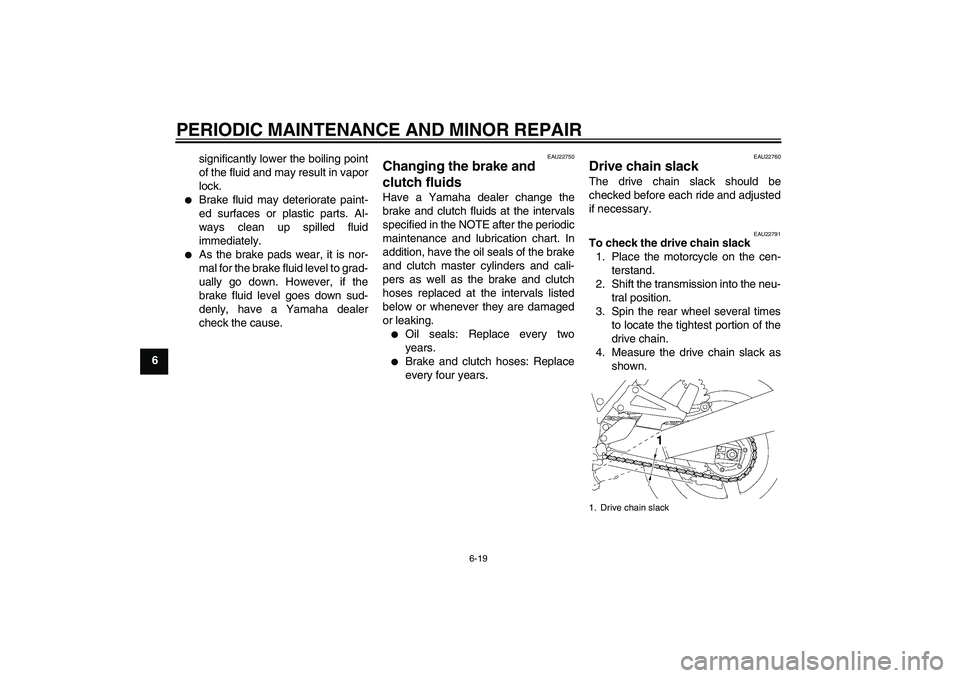Page 4 of 90

IMPORTANT MANUAL INFORMATION
EAU10151
Particularly important information is distinguished in this manual by the following notations:NOTE:�
This manual should be considered a permanent part of this motorcycle and should remain with it even if the motorcycle
is subsequently sold.
�
Yamaha continually seeks advancements in product design and quality. Therefore, while this manual contains the most
current product information available at the time of printing, there may be minor discrepancies between your motorcycleand this manual. If you have any questions concerning this manual, please consult your Yamaha dealer.WARNING
EWA10030
PLEASE READ THIS MANUAL CAREFULLY AND COMPLETELY BEFORE OPERATING THIS MOTORCYCLE.
*Product and specifications are subject to change without notice.The Safety Alert Symbol means ATTENTION! BECOME ALERT! YOUR SAFETY IS
INVOLVED!
Failure to follow WARNING instructions could result in severe injury or death
to the
motorcycle operator, a bystander, or a person inspecting or repairing the motor-
cycle.
A CAUTION indicates special precautions that must be taken to avoid damage to
the motorcycle.
A NOTE provides key information to make procedures easier or clearer.
WARNING
CAUTION:
NOTE:
U5WME3E0.book Page 1 Thursday, August 4, 2005 8:48 AM
Page 11 of 90

SAFETY INFORMATION
1-4
1 tor and may limit control ability,
therefore, such accessories are
not recommended.
�
Use caution when adding electri-
cal accessories. If electrical acces-
sories exceed the capacity of the
motorcycle’s electrical system, an
electric failure could result, which
could cause a dangerous loss of
lights or engine power.
Gasoline and exhaust gas
�
GASOLINE IS HIGHLY FLAMMA-
BLE:
Always turn the engine off when
refueling.
Take care not to spill any gaso-
line on the engine or exhaust
system when refueling.
Never refuel while smoking or in
the vicinity of an open flame.
�
Never start the engine or let it run
for any length of time in a closed
area. The exhaust fumes are poi-
sonous and may cause loss of
consciousness and death within a
short time. Always operate your
motorcycle in an area that has ad-
equate ventilation.
�
Always turn the engine off before
leaving the motorcycle unattended
and remove the key from the main
switch. When parking the motor-
cycle, note the following:
The engine and exhaust system
may be hot, therefore, park the
motorcycle in a place where pe-
destrians or children are not like-
ly to touch these hot areas.
Do not park the motorcycle on a
slope or soft ground, otherwise it
may fall over.
Do not park the motorcycle near
a flammable source (e.g. a kero-
sene heater, or near an open
flame), otherwise it could catch
fire.
�
When transporting the motorcycle
in another vehicle, make sure that
it is kept upright and that the fuel
cock is turned to “ON” or “RES” (for
vacuum type) / “OFF” (for manual
type). If it should lean over, gaso-
line may leak out of the carburetor
or fuel tank.
�
If you should swallow any gaso-
line, inhale a lot of gasoline vapor,
or allow gasoline to get into youreyes, see your doctor immediately.
If any gasoline spills on your skin
or clothing, immediately wash the
affected area with soap and water
and change your clothes.
U5WME3E0.book Page 4 Thursday, August 4, 2005 8:48 AM
Page 60 of 90

PERIODIC MAINTENANCE AND MINOR REPAIR
6-19
6significantly lower the boiling point
of the fluid and may result in vapor
lock.
�
Brake fluid may deteriorate paint-
ed surfaces or plastic parts. Al-
ways clean up spilled fluid
immediately.
�
As the brake pads wear, it is nor-
mal for the brake fluid level to grad-
ually go down. However, if the
brake fluid level goes down sud-
denly, have a Yamaha dealer
check the cause.
EAU22750
Changing the brake and
clutch fluids Have a Yamaha dealer change the
brake and clutch fluids at the intervals
specified in the NOTE after the periodic
maintenance and lubrication chart. In
addition, have the oil seals of the brake
and clutch master cylinders and cali-
pers as well as the brake and clutch
hoses replaced at the intervals listed
below or whenever they are damaged
or leaking.�
Oil seals: Replace every two
years.
�
Brake and clutch hoses: Replace
every four years.
EAU22760
Drive chain slack The drive chain slack should be
checked before each ride and adjusted
if necessary.
EAU22791
To check the drive chain slack
1. Place the motorcycle on the cen-
terstand.
2. Shift the transmission into the neu-
tral position.
3. Spin the rear wheel several times
to locate the tightest portion of the
drive chain.
4. Measure the drive chain slack as
shown.1. Drive chain slack
U5WME3E0.book Page 19 Thursday, August 4, 2005 8:48 AM